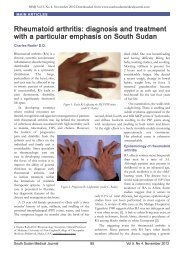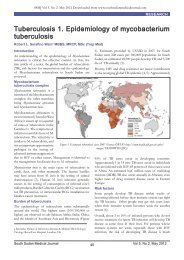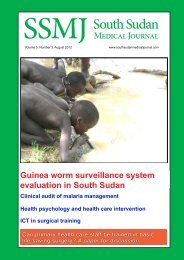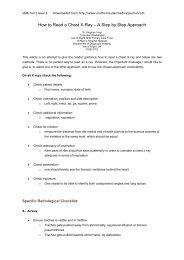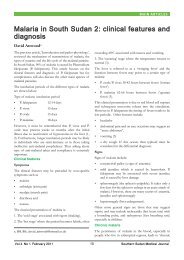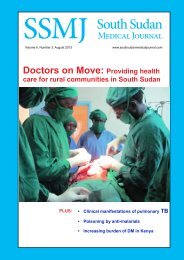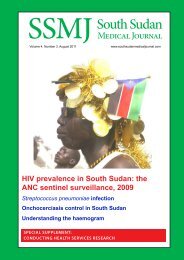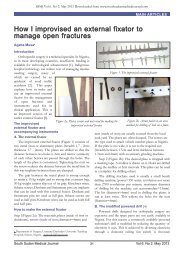Download Edition as PDF - South Sudan Medical Journal
Download Edition as PDF - South Sudan Medical Journal
Download Edition as PDF - South Sudan Medical Journal
Create successful ePaper yourself
Turn your PDF publications into a flip-book with our unique Google optimized e-Paper software.
SOUTHERN SUDAN MEDICAL BULLETINVolume 1, Issue 4. November 2008Chest Xray of a girl with hydatid dise<strong>as</strong>e showing elevated right hemi-diaphragm secondary to m<strong>as</strong>sive hepatomegally and apulmonary hydatid cyst in the left upper zone. Credit: James ArytonTo inform, educate and positively influence thedevelopment of Health Services in the <strong>South</strong>ern <strong>Sudan</strong>ContentsEditorial . . . . . . . . . . 2Guidelines for the Management of Suspected Microbial Keratitisin Settings with Limited Laboratory Facilities Wani MG . . . 3 .Preventing Iron Deficiency and Anaemia Joseph Mutuku. . . 7The <strong>Medical</strong> and Social Consequences of Alcohol Abuse Eluzai Hakim. 10Mid Upper Arm Circumference. . . . . . . . 12Mpower! A Health Education Programme in Mundri . . . 13 .Summaries/Extracts from journals, reports, etc . . . . 14For your resource centre . . . . . . . . 15Notices. . . . . . . . . . . 16Information for authors . . . . . . . . 17
Guidelines for the Management ofSuspected Microbial Keratitis inSettings with Limited LaboratoryFacilitiesWani MG, Consultant Ophthalmologist,Sakubva Eye Unit, Mutare Zimbabwe aIntroductionMicrobial Keratitis, also referred to <strong>as</strong> SuppurativeKeratitis or Corneal Ulcer, is a potentially sightthreatening condition that may present to doctors andnurses working in State hospitals and eye units in<strong>South</strong> <strong>Sudan</strong>.Delay in treatment can result in development ofcomplications that may lead to loss of sight ordestruction of the eye. It is generally recommended thatcorneal scrapping and microscopic examination ofsmears be performed to identify organism type beforeinitiation of therapy and that culture and sensitivitytesting be undertaken to provide information necessaryfor subsequent treatment modification.These recommendations, although good, areimpractical in settings where laboratory facilities are notreadily available or reliable. In this c<strong>as</strong>e initial choice ofantibiotics therapy may be made without the benefit ofGram Stain Microscopy results.In recent years, a number of new broad spectrumantibiotics have been introduced that <strong>as</strong> single agentshave been effective in treating corneal ulcers. Thisseems to vindicate the position previously held by someophthalmologists that extensive laboratory workup,although essential, only rarely changes the course ofinitial therapy, regardless of the b<strong>as</strong>is on which suchtherapy w<strong>as</strong> chosen.A good history, clinical examination andknowledge of prevalence and sensitivity pattern of localisolates can <strong>as</strong>sist the clinician select appropriateantibiotics for initial treatment of suspected c<strong>as</strong>e ofmicrobial keratitis. This article presents guidelines thatwould aid the clinician in making such decision insettings where minimum or no laboratory supportexists.aP O Box 30, Mutare Zimbabwe, Email: wanimena atmutare.icon.co.zwMicrobial KeratitisThe cornea is the transparent av<strong>as</strong>cular part of the sclerathat lies in front of the eye protected by the eyelids. It iscovered by epithelium that provides the first line of defenceagainst invading micro-organisms. The tear film spread onits surface by the blinking action of the lids containslysozymes that have antibacterial activity against mostbacteria.Suppurative Corneal ulcer occurs following inv<strong>as</strong>ionof the cornea by pathogenic bacteria capable of penetratingintact epithelium such <strong>as</strong> corynebacterium Diphtheriae,Neisseria Gonorrhoeae and H. influenzae. Non surgicaltrauma is the commonest factor predisposing the cornea toinfection with less virulent organisms that are usualcommensals of the lid. Spontaneous inv<strong>as</strong>ion of the corneamay occur in patients with previous history of HerpesSimplex, Exposure Keratopathy, Diabetes Mellitus, contactlens wear and general immune suppression.The prevalence of blindness directly resulting fromcomplications of Suppurative Keratitis is estimated to be5% 1 . This figure is likely to incre<strong>as</strong>e <strong>as</strong> other causes ofcorneal blindness decre<strong>as</strong>e with improvement inimmunization against me<strong>as</strong>les, control of Xerophthalmia,and other corneal blinding dise<strong>as</strong>es. In developing regionslike India, Africa and Asia, Suppurative Keratitis is thesecond commonest cause of uniocular blindness aftercataract 2 . Blindness caused by sequale of SuppurativeKeratitis can be considered irreversible in parts of the worldwhere corneal grafting services are non existent. Patientsare therefore at incre<strong>as</strong>ed risk of total blindness if the othereye should lose sight to other blinding conditions. Earlyrecognition and treatment are therefore important to avertthe sight threatening complication of this conditionThe cornerstone of effective treatment is informedinitial antibiotic choice with later modification <strong>as</strong> clinicalcause dictate. At a primary and secondary eye care leveland sometime in tertiary eye care centres without adequatelaboratory support, such a choice h<strong>as</strong> often to be madewithout the benefit of laboratory data.Careful history, consideration of risk factors,evaluation of clinical characteristics of the ulcer and<strong>South</strong>ern <strong>Sudan</strong> <strong>Medical</strong> Bulletin Volume 1, Number 4, November 2008 3
ulcers produce copious greenish yellow discharge andprogress rapidly to hypopion formation and cornealperforation. The surrounding cornea may have ground gl<strong>as</strong>sappearance.The most common bacteria include StaphylococcusEpidermidis, Stapohylococcus aureus, Pseudomon<strong>as</strong>Aeruginosa and streptococcus Pneumoniae. Fusareum andAspergillus are common fungiinstances Gram Stain missed organism that weresubsequently recovered on culture.Table 1. Identification of organisms by gramstain and cultureGram stain Culture %Organismsdemonstrated onstainNo organismsdemonstrated onstainNo organismsdemonstrated onstainCorrespondingorganisms recoveredon cultureOrganisms recoveredon cultureNo organismsrecovered on culture264925Fig 2 Fungal ulcer - note feathery edgesValue of Gram Stain Microscopy in EtiologicDiagnosis of Corneal UlcersGram Stain Microscopy [GSM] is the recommendedlaboratory procedure that should be performed before initialantibiotic therapy is started. Where laboratory facilities areavailable this should be done <strong>as</strong> a routine procedure..Where laboratory facilities are not adequate, it will be limitedto c<strong>as</strong>es with severe ulcers or when fungal infection issuspected from history or clinical examination. Gram stainwill enable broad cl<strong>as</strong>sification of organisms into GramPositive and Gram Negative <strong>as</strong> well <strong>as</strong> fungal. It will alsofacilitate the building of a local datab<strong>as</strong>e to act <strong>as</strong> areference for future treatment decision and to examinechanges in trends.Sensitivity of Gram Stain Microscopy [GSM] varies indifferent studies ranging from 36% - 50% 7-9 . GSM tends tobe positive in severe c<strong>as</strong>es of bacterial infection or fungalinfection and when antibiotic h<strong>as</strong> not been used prior topresentation to hospital. It tends to be negative in small tomedium ulcers.Culture is the Gold standard that can confirm resultsof GSM and provide sensitivity data to enable modification ofinitial therapy. Corneal infiltrate should be sent for culture inall c<strong>as</strong>es of severe ulcers, suspected fungal infection andthose that are refractory to treatment. McLeod et al 8(seeTable 1) compared the recovery rate of organisms byGram Stain and Culture and found that in almost 49% ofIn some c<strong>as</strong>es 10 , culture w<strong>as</strong> not only negative in ac<strong>as</strong>e of positive smear but in fact it yielded differentorganisms from those seen on smear. From these studies,Only in a quarter of c<strong>as</strong>es does culture result confirm apositive or negative smear.Some of the re<strong>as</strong>ons for the high false negativeGSM rate are that patients with suppurative Keratitis usuallyalways present late to hospital after a failed home treatmentwith either antibiotics or traditional eye medicine. Thematerial obtained during scrapping is often small hence maynot be sufficient for processing. Interpretation of cornealsmears, traditionally done by primary physicians is timeconsuming and may call for expert knowledge of thepractitioner.Proper materials for obtaining corneal scrapping maynot be stocked at the practitioners’ office in adequatequantities. Thus it w<strong>as</strong> shown 8 that where scrappings waredone, the procedure w<strong>as</strong> often performed using cottontipped applicator contrary to textbook recommendation that ametal Kumura spatula or wooden applicator be used in allc<strong>as</strong>es. All these shortcomings may lead to low harvest ratesof organisms seen in GSM.Choice of initial antibiotic therapyInitial antibiotic therapy may be chosen on the b<strong>as</strong>is of GramStain Microscopy where this is available or it can be b<strong>as</strong>edon knowledge of most likely organisms <strong>as</strong> reported in localliterature.<strong>South</strong>ern <strong>Sudan</strong> <strong>Medical</strong> Bulletin Volume 1, Number 4, November 2008 5
Evaluation of a patient with corneal ulcer1. Take a good history paying attention to injuryespecially vegetative injury.2. Find out if patient h<strong>as</strong> instilled any traditionalmedicine preparation into the eye.3. Carefully examine the ulcer and note presenceof discharge, appearance of feather margins,and presence of satellite lesions, impendingperforation and presence of hypopion.4. Make a tentative diagnosis and chose initialbroad spectrum antibiotics according toknowledge of prevalence and sensitivity.Initial therapy b<strong>as</strong>ed on results of Gram StainMicroscopy - see Table 2.• If GSM shows a single organism, start therapy withtopical Ciprofloxacin 0.3% given frequently two hourlytill improvement then reduce to TDS.• If GSM shows mixed organisms: start combinationtherapy with topical cefazolin and Gentamicin twohourly and <strong>as</strong>sess daily.• If GSM shows presence of Fungi or positive history ofvegetative injury – add an antifungal either Natamycinor Econazole eye drops TID.Modify therapy if no improvement and according to cultureand sensitivity results. Do not change therapy if patient isimproving on current therapy even if sensitivity resultsindicate lack of sensitivity to the antibiotic in use.Table 2. Choice of antibiotics b<strong>as</strong>ed on resultsof GSMOrganismFrequency DurationDrugidentifiedby GSMSinglebacterialpathogenTopicalCiprofloxacineye drops2-hourlyuntilimprovement then 37 days oruntil cureMixedbacterialpathogensFungalelementsCombinationtherapy withtopicalCefazolin andGentamicin0.3% eyedropsTopicalNatamycin5% orEconazoleeye dropstimes/day2-hourlyuntilimprovement then3-hourly3times/day7 days7 daysInitial therapy b<strong>as</strong>ed on prevalence of localisolates1. Always <strong>as</strong>sume mixed infection with both gram positiveand gram negative organisms.2. If there is a history of vegetative injury or use of TEM,<strong>as</strong>sume presence of fungi and evaluate ulcer carefullyfor signs of fungal infection such <strong>as</strong> feathery margins,satellite lesions etc.3. Note if the patient is using contact lens.4. Start broad spectrum antibiotics therapy with thefollowing combination:• Topical fortified Cephazolin 5% or Ciprofloaxcin0.3% combined with fortified Gentamicin 1.4% andNatamycin 5% or Econazole.• Combine both Subconjuntival injection of Gentamicinand topical eye drops.• Give eye drops half hourly until improvement, thenreduce to TDS.How to prepare fortified antibiotic eye dropsGentamicinAdd 2ml parental Gentamicin (80mg) to 5ml ofcommercial Gentamicin ophthalmic solution(0.3%) to get final concentration of 14mg/ml.CefuroximeDilute 1g parental Cefuroxime in 2.5ml sterilewater.Take 2.5ml of this solution and add to 12.5ml ofartificial tears to get final concentration of50mg/ml.References1. Whitcher J, Srinivansan M, Corneal Ulceration in thedeveloping World. Br J Ophthalmol 1997; 622-623(August)2. Brillant LB, Pokhrel RP, Gr<strong>as</strong>set NE, Lepkowski JM,Kolstrad A, Hawks W, Pararajagaram R et alEpidemiology of blindness in Nepal Bull World healthorgan. 1985; 63(2): 375-863. Thom<strong>as</strong> PA, Leck AK, Myatt M Characteristic clinicalfeatures <strong>as</strong> an aid to diagnosis of Suppurative keratitiscaused by filamentous fungi British <strong>Journal</strong> ofOphthalmology 2005;89:1554-15584. Leck AK, Thom<strong>as</strong> PA, Hagan M, et al. Aetiology ofsuppurative corneal ulcers in Ghana and south India, andepidemiology of fungal keratitis. Br J Ophthalmol2002;86:1211–15. Prajna VN, Pillai MR, Manimegalai TK, Sriniv<strong>as</strong>an M.Use of traditional eye medicines by corneal ulcer patientspresenting to a hospital in <strong>South</strong> India. Indian JOphthalmol 1999;47:15-86. Courtright P, Lowallen S, Kanjalotis S, Divala DJ.Traditional eye medicine use among patients withcorneal dise<strong>as</strong>e in rural Malawi. Br J Ophthalmol 1994;78: 810-127. Sharma S, Kunimato DY, Gopinathan U, Athmanathan S,Grag P, Rao GN. Evaluation of corneal scrapping smearexamination methods in diagnosis of bacterial andFungal Keratitis: Survey of 8 years of laboratoryexperience. Cornea 2002 Oct; 21(7): 643-78. Stephen D, McLeod MD, Amir Kakahdouz Isfahni et al;Role of smears, cultures & antibioiotic sensitivity testingin management of suspected infectious Keratitis.Ophthalmology Vol 103 No 1 Jan 19969. Wani MG, Makanganwi A, Guramatunhu S, Prevalenceand Causes of Corneal Ulcers seen at Sekuru KaguviEye Hospital in Harare Zimbabwe. Cent Afr J Med2001;47(5):119-2310. Poole TRG, Hunter DL, Maliwa EMK, Ramsay ARCAetiology of Microbial keratitis in Nothern Tanzania. Br JOphthalmol 2002; 86; 941-9426<strong>South</strong>ern <strong>Sudan</strong> <strong>Medical</strong> Bulletin Volume 1, Number 4, November 2008
Preventing Iron Deficiency andAnaemiaJoseph Mutuku, PhD Candidate, WageningenUniversity and Research Centre, Netherlands,formerly with Micronutrient Initiative, Kenya *Anaemia, often due to iron deficiency, is one ofthe most widespread causes of mortality andmorbidity in <strong>South</strong>ern <strong>Sudan</strong>, which probably h<strong>as</strong>probably one of the highest rates in the world.Anaemia means a person h<strong>as</strong> a haemoglobin orhaematocrit below the values in Table 1. It occurswhen the body produces too few healthy redblood cells, loses too many or destroys themf<strong>as</strong>ter than they can be replaced.Causes of anaemia and iron deficiencyAnaemia is caused one or more of the following:• Iron deficiency that accounts for about 50%of anaemia c<strong>as</strong>es worldwide. Iron deficiencyis caused by:• a diet low in bioavailable iron.• loss of blood due to heavy menstruation,injuries, bleeding during delivery, orhookworm or schistosomi<strong>as</strong>is infections.• intestinal disorders affecting ironabsorption.• Deficiency of vitamin B12, vitamin Aand/or folate. Folate deficiency causesmegalobl<strong>as</strong>tic anaemia. Folate needs arehigh during pregnancy.• Non nutritional causes such sickle celldise<strong>as</strong>e and infections especially malaria,HIV/AIDS.Anaemia is common among young children andwomen of reproductive age because:• Young children are growing f<strong>as</strong>t and so mustmake new red blood cells quickly.• Women and girls of reproductive age loseblood each month.• Pregnant women must make many new redblood cells, provide iron for the foetus and maylose much blood during childbirth.Dangers of anaemia and iron deficiency• Severely anaemic people, including children,often die.• Anaemia in pregnancy results in:• less iron p<strong>as</strong>sing from mother to foetusso the newborn h<strong>as</strong> low iron stores• incre<strong>as</strong>ed risk of blood loss during andafter delivery, and of maternal death*Division of Human Nutrition, Wageningen University andResearch Centre, Agrotechnology and Food Sciences Group,Netherlands and c/o P.O Box 60066-00200, Nairobi, Kenya.Joseph.mutuku at gmail.com• incre<strong>as</strong>ed risk of the baby being preterm,having a low birth weight and dying.• Anaemia in surgical patients incre<strong>as</strong>es therisk of postoperative problems and death.Some people may not be cl<strong>as</strong>sified <strong>as</strong> ‘anaemic’but are iron deficient. Iron deficiency (evenwithout anaemia) reduces the immune status of allage groups and:• Iron-deficient young children are apathetic andless active, and at risk of poorer-than-normalemotional and behavioural development.• Iron-deficient older children and adults havepoorer-than-normal ability to concentrate or dophysical work for long periods.Diagnosing iron deficiency and anaemiaBiological methodsThe methods usually available in <strong>South</strong>ern <strong>Sudan</strong>to diagnose anaemia are haemoglobin (see Table1), mean corpuscular volume (MCV) and meancorpuscular haemoglobin concentration (MCHC).However, these can give misleading results ifthere is infection and do not necessarily mean aperson is iron deficient.People with infections especially HIV or otherserious infections are often anaemic but may notbe iron deficient. In the immune response toinfection the body takes iron from the blood andstores it in the liver. Giving iron to these patientsmay be dangerous. Tests for iron deficiencyinclude serum ferritin, serum transferrin receptorand zinc protoporphyrin (ZnPP). Refer patientswith HIV or other serious infections for one ofthese tests when possible, or seek senior opinion.Table 1. Haemoglobin and haematocrit cut-offlevels for anaemia 1Age/Sex Haemoglobin(Hb) belowHaematocritbelowg/L %6– 59 months 110 335 – 11 years 115 3412 – 14 years 120 36Females >15 yrs:- not pregnant- pregnant1201103633Males >15 years 130 39• In adults and adolescents: if haemoglobin is:
• An indication of iron deficiency is flattingand thinning, and later spooning, offingernails and/or a diet low in available iron –see Box 1.Ask about symptomsAn anaemic person may complain of:• Feeling tired, ill, dizzy, or breathless whenresting.• Headache, f<strong>as</strong>t-beating heart or swollen feet.Find possible causes• Ask about the diet, especially about foodsthat are iron-rich and/or incre<strong>as</strong>e or reduceiron absorption – see Box 1.• Ask about heavy bleeding or chronic bloodloss.• Examine or <strong>as</strong>k about present or previoussevere infection such <strong>as</strong> HIV, malaria ortuberculosis,• Examine for intestinal par<strong>as</strong>ites and <strong>as</strong>k ifperson h<strong>as</strong> been de-wormed.Preventing iron deficiency and anaemia• Help families and communities to understandthe causes and dangers of iron deficiencyand anaemia.• Explain that:• women need adequate iron stores beforeand during pregnancy - because ofincre<strong>as</strong>ed needs and to ensure babies areborn with good stores. Their need forfolate also incre<strong>as</strong>es.• spacing births gives women a chance to‘fill up’ iron stores between pregnancies.• bre<strong>as</strong>tfeeding exclusively for 6 months –which, among other benefits to motherand baby, delays menstruation.• young children should not be fedunfortified commercial milk.• Discuss practical ways to improve diets,particularly for women and young children(see below).• Give prophylactic iron and folic acidsupplements to iron deficient persons.• Prevent or treat non-dietary causes ofanaemia.During and after childbirth:• Control bleeding by encouraging women to:• be delivered by a trained birth attendant or at amaternity unit if there is a risk of complications.• start bre<strong>as</strong>tfeeding within ½ hour of birth.Bre<strong>as</strong>tfeeding makes the mother's uterustighten and reduces bleeding.• Wait two minutes after birth before clampingthe umbilical cord so the baby gets moreblood from the placenta.Give prophylactic supplements• Give oral iron and folic acid supplements topregnant and lactating women, to females ofreproductive age and to low birth weightbabies – see Table 2.• Do not give routine prophylactic iron or folicacid to children in malaria endemic are<strong>as</strong> <strong>as</strong> itmay incre<strong>as</strong>e adverse effects and mortalityunless they are proven to be iron-deficient 2 .• Explain the importance of taking supplementsregularly for the full duration and how to dealwith possible side effects – see Box 2.Box 1. Improving dietsThere are two forms of iron in foods:Haem iron is type of iron in the blood, muscle andorgans of animals, poultry, andfish – see pictures.Non-haem iron is the type ofiron in plants, milk, and eggs.Non-haem iron in bre<strong>as</strong>t milk iswell absorbed but is poorlyabsorbed from most other foods — usually about5% to 10%. However the proportion absorbeddepends on:• Other foods in the meal. Meat, fish and vitamin C–rich foods (fresh fruits and vegetables) incre<strong>as</strong>eabsorption. Fermenting andgerminating/malting cereals and legumes alsoimprove absorption. Some foods contain antinutrientsthat decre<strong>as</strong>e absorption if taken with,or immediately after, foods containing nonhaemiron. These include tannins in tea andcoffee and phytates in cereals.• Iron needs. People with high iron needs (e.g.pregnant women or people with anaemia)absorb more than other people.To prevent iron deficiency advise families to:• Eat more meat (of any kind), fish, poultry andorgan meats – the darker red the food the morehaem iron it contains. These foods must be wellcooked to kill par<strong>as</strong>ites and pathogens.• Eat more fresh vegetables and fruits (toincre<strong>as</strong>e absorption of non-haem iron fromother foods in a meal). Foods high in nonhaemiron include egg yolk, dark greenvegetables, millet, sorghum and legumes.• Avoid drinking tea or coffee with or soon aftermeals. Do not give tea and coffee to children.• Eat fermented porridges and germinate/maltcereals and legumes to reduce phytates.• Eat foods fortified with iron if fe<strong>as</strong>ible, such <strong>as</strong>some wheat flours. Families can use homefortification products if available.• Bre<strong>as</strong>tfeed babies exclusively for 6 months andthen to include iron-rich foods such <strong>as</strong> suitablyprepared meat or fish in their diets.8<strong>South</strong>ern <strong>Sudan</strong> <strong>Medical</strong> Bulletin Volume 1, Number 4, November 2008
Table 2. Prophylactic oral iron and folic aciddosage schedules to prevent and correct irondeficiency anaemia 1,3,4Group Dosage/day a DurationLow birthweight infants
Note: We plan to cover the management ofanaemia due to non-dietary causes in futureissues.A good dietprevents irondeficiencyanaemiaFrom Nutrition during pregnancy and lactation. Job Aids on HIV andInfant Feeding. University Research Co., LLC/Quality AssuranceProject http://www.qaproject.org/strat/stratHIVjobaidsintro.htmReferences1. WHO/UNU/UNICEF. 2001. Iron deficiency anaemia,<strong>as</strong>sessment, prevention and control: a guide forprogramme managers. Geneva.2. Sazawal S, Black RE, Ramsan M, Chwaya HM, etalEffects of routine prophylactic iron and folic acid onadmission to hospital and mortality in pre-school childrenin a high malaria transmission setting: community-b<strong>as</strong>edrandomised placebo-controlled trial. Lancet: 367: 133-43,20063. Stoltzfus R., Dreyfuss M. 1998. Guidelines for the use ofIron Supplements to Prevent and Treat Iron DeficiencyAnaemia. ILSI Press W<strong>as</strong>hington.4. WHO 2005 Pocketbook of Hospital Care For Children:Guidelines For The Management Of Common IllnessesWith Limited Resources (pages 276-77), WHO, Geneva.http://Whqlibdoc.Who.Int/Publications/2005/9241546700.PdfWith thanks to Dr Louis Danga forcontributing to this article and to Drs PaulineAndang’o, Alan Jackson and Lucy Malaba fortheir advice.The <strong>Medical</strong> and Social Consequencesof Alcohol AbuseFirst of Two ArticlesDr Eluzai Hakim, FRCP Consultant Physician,St Mary’s Hospital, Newport, Isle of WightPO30 5TG UK *IntroductionThe prevalence of alcohol related illness in the<strong>South</strong>ern <strong>Sudan</strong> is unknown, though there isanecdotal information that alcohol relatedviolence, marital discord, absenteeism from workand road traffic accidents which are related to theuse of alcohol are common.Humans have drunk alcohol for at le<strong>as</strong>t twelvethousand years. It h<strong>as</strong> been used in religiousrituals, in ancient cultures <strong>as</strong> diverse <strong>as</strong> Samaria,Babylon, Egypt, China and Anglo-Saxon Britain 1 .According to the World Health Organisation(WHO) 1.8 million people worldwide died in 2000from alcohol related causes, 3% of all deathsworldwide 2 . In 2001, up to 1,000 of 3,479 deathsfrom suicide and self-inflicted injury were<strong>as</strong>sociated with the misuse of alcohol in theUnited Kingdom 3 . In the United States ofAmerica, each year 85,000 deaths occur alongwith substantial disability from medical,psychiatric consequences, injuries and “secondhand”effects such <strong>as</strong> road traffic accidentsattributed to the use of alcohol. The estimatedannual cost attributable to alcohol use in theUnited States is equivalent to US$185 billion 4 .As peace takes root in the <strong>South</strong>ern <strong>Sudan</strong>, sodoes social life outside a war situation lubricatedwith a drink or two. Repeated use of alcoholleads to habituation due to induction of liverenzymes, which incre<strong>as</strong>e the breakdown of*eluzai_hakim at yahoo.co.ukalcohol. Consequently more alcohol is drunkeach time in order to produce the same effect.What is alcohol?Alcohol or ethanol (C 2 H 5 OH) is a drug. It is <strong>as</strong>mall water soluble molecule, a proportion ofwhich is absorbed directly but slowly from thestomach. It is absorbed more rapidly from thesmall intestine and is freely distributed throughoutthe body. Absorption of alcohol is quicker if it isdrunk on an empty stomach. Sherry with analcohol concentration of 20% incre<strong>as</strong>es bloodconcentration more rapidly than beer (3 – 8%).Spirits such <strong>as</strong> whisky and gin (40%) delayg<strong>as</strong>tric emptying and inhibit alcohol absorption.Hence people may still feel drunk the followingday after much consumption of whisky or gin.Drinks aerated with carbon dioxide, for examplewhisky and soda and champagne, are absorbedquicker 5 .Human factors in alcohol absorptionAlcohol is distributed in water throughout thebody, reaching different parts such <strong>as</strong> the brain,muscles, liver and the bone marrow. Exposureof the liver to alcohol is greatest because bloodreceived from the stomach and intestine reachesthe liver through the portal vein, which drainsthose structures. Relatively little alcohol entersfat tissue due to its poor solubility in fat.Compared with males, females have relativelyhigher fat content and hence blood and tissueconcentrations of alcohol are higher in females 5 .However other factors may also play a part inmaking females susceptible to the effects ofalcohol.<strong>Medical</strong> effects of alcohol• Disruption of motor coordination such <strong>as</strong>driving a car or walking in a straight line dueto effects of alcohol on the cerebellum, thepart of the brain which modulates sensory-10<strong>South</strong>ern <strong>Sudan</strong> <strong>Medical</strong> Bulletin Volume 1, Number 4, November 2008
motor coordination. This predisposes to roadtraffic accidents, falls and other injuries.• Removal of the voluntary control ofbehaviour (self control) and restraintexercised by the body through the prefrontalcortex of the brain. Hence those who haveconsumed much alcohol may becometalkative, seek fights or urinate in publicwithout due regard for the presence of otherpeople 1 .• Those consuming alcohol may seek rewardssuch <strong>as</strong> sexual gratification without thinking ofthe consequences of their actions - such <strong>as</strong>unplanned pregnancy, or engaging inunprotected sexual intercourse - with thepotential result of contracting seriousillnesses such <strong>as</strong> HIV/AIDS.• Loss of intellectual abilities such <strong>as</strong>memory, judgement, abstract thinking andre<strong>as</strong>oning. Being uncaring and untidy aboutone’s personal appearance may be the firstsigns of alcohol abuse particularly in personsin responsible positions.• Blindness due to optic atrophy if alcoholcontaminated with methanol in poor brewingconditions is consumed. C<strong>as</strong>es ofunexplained blindness in some middle cl<strong>as</strong>s<strong>South</strong>ern <strong>Sudan</strong>ese who have consumedlocally distilled gin regularly have been notedover the years.• Damage to peripheral nerves manifesting <strong>as</strong>foot drop, burning sensation in the feet andhands and leading to dropping of objectssuch <strong>as</strong> cups held or falls at the slightesttripping.• Direct injury to heart muscle(cardiomyopathy) <strong>as</strong>sociated with atrialfibrillation (irregular heartbeat) leading toheart failure and strokes.learning, slow reaction time and poor problemsolving.• Dehydration: alcohol inhibits the rele<strong>as</strong>e ofv<strong>as</strong>opressin from the posterior pituitary glandleading to incre<strong>as</strong>e in urine volume andconsequently dehydration. This may leadto kidney failure if not corrected.Social effects of alcohol• Marital disharmony <strong>as</strong> a result of c<strong>as</strong>hcrisis, domestic violence, loss of job andsocial exclusion.• Violence leading to homicides, <strong>as</strong>saults andsometimes burglary.• Failure at examinations for those who are atschool, college or university.• Loss of trust by those close to the personabusing alcohol (no-one trusts a drunkard!).These are some of the major consequences ofchronic and excessive alcohol consumption. Inthe next article I shall be writing about themanagement of problem drinking to avoid thedevelopment of these problems. Drunk in smallquantities alcohol may be beneficial.There are ways round problems in life other thanis encapsulated in this quote, “Alcohol is theanaesthesia by which we endure the operation oflife” George Barnard Shaw 1856 – 1950.References1. Alcohol and Human Health. Eds. Lesley Smart,Oxford University Press 2007.2. World Health Organisation 2002.3. ABC of Alcohol. Ed Alex Paton and RobinTouquet, Blackwell Publishing 4 th <strong>Edition</strong> 2005.4. Richard Saitz, Unhealthy Alcohol use. NEJM2005; 352:596 – 607.5. BMJ 2005; 330: 85 – 87.6. National Institute of Alcohol Abuse and Alcoholism2000.http://pubs.niaaa.nih.gov/publications/aa50.htm.• Chronic pancreatitis and ultimately diabetes.• Gynaecom<strong>as</strong>tia (enlarged bre<strong>as</strong>ts in men),atrophy of testicles and erectileimpotence. This is believed to be due to theeffect of oestrogens whose concentrationincre<strong>as</strong>es in the body <strong>as</strong> a result of poorinactivation in the liver which h<strong>as</strong> alreadybeen rendered cirrhotic by excessiveconsumption of alcohol.• Foetal alcohol syndrome: excessive alcoholconsumption during pregnancy leads to foetalretardation, central nervous systemabnormalities in the foetus such <strong>as</strong> smallopenings between the eyelids, thin upper lid,upturned nose, parallel folds on ears andmental retardation leading to impaired<strong>South</strong>ern <strong>Sudan</strong> <strong>Medical</strong> Bulletin Volume 1, Number 4, November 2008 11
Tapes for me<strong>as</strong>uring Mid Upper ArmCircumference (MUAC)Professor David Morley, TALC, Po.O. Box 49,St Albans, AL1 5TX, UKdavid at morleydc.demon.co.ukAt a time when food is in short supply it isessential to have a simple method of identifyingmalnourished young children. The mid upper armcircumference (MUAC) of children aged 6 – 59months gives an indication of the degree ofw<strong>as</strong>ting and is a good predictor of mortality.Research shows that it is equally good, if notbetter, than other me<strong>as</strong>urements for screeningyoung children and selecting those needingtherapeutic feeding 1 .The MUAC tape (see figure) is a simple andreliable method of <strong>as</strong>sessing MUAC and can, withtraining, be used by all level of health workers.Teaching-aids At Low Cost (TALC) h<strong>as</strong> beenproducing MUAC tapes for over 10 years andthey have stood the test of time, with over aquarter of a million having been distributed. Theyare made from pl<strong>as</strong>ticized paper and are almostindestructible.The tapes show colour-coded cut-off pointsindicating various levels of malnutrition for youngchildren, and, on the back, suggest cut-off levelsto identify at-risk pregnant women and adults withHIV/AIDS and/or tuberculosis.The TALC MUAC tape and how to use itReferences1. Myatt Mark, Khan Tanya, Collins Steve. A review ofmethods to detect severe malnutrition in the community fortheir admission to community b<strong>as</strong>ed therapeutic feedingcentres Food and Nutrition Bulletin 2006 No3 supplement TheUnited Nations UniversityMUAC – how to me<strong>as</strong>ure and whenuse it 1,2How to me<strong>as</strong>ure MUACMUAC is thecircumference of the leftupper arm and isme<strong>as</strong>ured at the mid-pointbetween the tips of theshoulder and elbow. To me<strong>as</strong>ure:1. Bend the left arm, find and mark with a penthe olecranon process and acromium.2. Mark the mid-point between these two marks.3. With the arm hanging straight down, wrap aMUAC tape around the arm at the midpointmark.4. Me<strong>as</strong>ure to the nearest 1 mm.It is e<strong>as</strong>y to me<strong>as</strong>ure MUAC even on very thinarms.When to use MUACThe major determinants of MUAC are muscle andsub-cutaneous fat, both important determinants ofsurvival in malnutrition and starvation. MUAC isless affected than weight and height b<strong>as</strong>edindices (e.g. Body M<strong>as</strong>s Index) by accumulationof fluid (i.e. nutritional oedema, peri-orbitaloedema and <strong>as</strong>cites). So MUAC is a goodpredictor of mortality. It is recommended foridentifying young children with, or at risk of,severe acute malnutrition and adults with acuteenergy deficiency.In children 6-59 month old, MUAC
Mpower!…A Health EducationProgramme in MundriContributed by Loes J<strong>as</strong>pers loesj<strong>as</strong>pers atgmail.com. Photos from Mpower!How did it all start?Mpower! is a collaborative project of theInternational Federation of <strong>Medical</strong> Students’Associations-The Netherlands (IFMSA-TheNetherlands) and the Mundri Relief andDevelopment Association (MRDA).Mpower! is a ‘training of trainers’ projectorganized by Dutch medical students in close<strong>as</strong>sociation with <strong>South</strong> <strong>Sudan</strong>ese peers.From June-December 2007 the students andpeers worked really hard to create a healtheducation programme that deals with matters likehealth, sexuality, hygiene, sanitation, HIV/AIDS,safety, human rights and nutrition.The results are stunning. A group of 40 localtrainers are trained to give workshops in threedifferent topics. For each of these topics amanual w<strong>as</strong> developed. The 3 topics are:1. Nutrition2. Sexual and Reproductive Health3. Hygiene and SanitationYou can view the manuals online athttp://www.roelkw.com/mpower/manuals/How did it continue?During the workshops we noticed there w<strong>as</strong> aneed for a focus on children (see photo of Julius,one of the trainees). Mothers <strong>as</strong>ked manyquestions about child health care. "How can Itake care of my child?", "How can I see when mychild is sick?", "How can I love my child?". Inresponse to this need a second project w<strong>as</strong>developed in 2008 with a special focus onchildren. Below you can find the outline of therenewed project.Mundri Under 5 ClinicThis clinic will become the heart of the project -see below.Health EducationWorkshops are given in the three topics ofMpower! listed above. The difference to l<strong>as</strong>t yearis the special focus on children. A group of 9trainers are being specially trained to give theseworkshops.Subjects for the workshops are:1. Nutrition focus on children, pregnantwomen and a balanced diet2. Sexual health and human rights focus onfamily planning, STD’s, HIV/AIDS and humanrights3. Hygiene and Sanitation focus on generalhygiene and personal hygiene of mother andchild.Home visitsThe trainers will be visiting homes in order toreach people who live far outside the community.During these visits the trainers will discuss theimportance of hygiene, sanitation and a goodnutrition, and deal with family health issues. Theywill fill in checklists on sexual and reproductivehealth, and child health care. This will give theMpower! crew the chance to get insights into theknowledge of the community. This is not onlyimportant for the people of Mundri, but also forour founders in The Netherlands and futurefunders.Vaccination and Prevention ProgrammeThis is final part of the project and isindispensable to secure the health of youngchildren. We are investigating with differentNGOs and funders the possibilities to implementroutine vaccinations for all children in Mundri.Already two people involved in the project arecapable of giving vaccinations. The biggestdifficulties will be power failures and a reliablesupply of vaccines.Happily Ever After?We startedimplementingMpower! in June2007 so it is still ayoung project. Forthe momenteverything is goingvery well and there isenough money tocontinue it for sometime. But for thisproject to besuccessful in thefuture, more moneywill be needed. We are now busy writing topotential funders in the hope that there will besufficient money for Mpower! to continue <strong>as</strong> <strong>as</strong>uccessful project for many years to come!Trainees were: Julius Bidal Morobu, Atim H<strong>as</strong>senGerman, Rebecca Ezibon Tona, Benjamin BishopWisely, Stephen Sabah Wisely, Venson JulyKenneth, Charity Edward, Cecilia Amjuma Bona,Sebit Manza Faki, Helida Saluwa Abel, Isaac OpiRepent, Michael Abdallah Paul, Elizabeth SilvanoFaki, Jackson Monday Mbari, Viviana KidenApollo, Stephen Sim<strong>as</strong> Simon.<strong>South</strong>ern <strong>Sudan</strong> <strong>Medical</strong> Bulletin Volume 1, Number 4, November 2008 13
Mundri Under 5 ClinicWe are presently starting the very first Under 5 clinic in Mundri. Thegeneral Health Care Centre h<strong>as</strong> donated a building to Mpower! for thispurpose. The building is in a very bad condition, but we have alreadystarted the renovation (see photo). This clinic will become the heart ofthe Mpower! project. The trainers will use it <strong>as</strong> their headquarters and thebuilding will be used to:• give education and health advice OR give nutrition and healtheducation/advice• weigh and me<strong>as</strong>ure children using their own growth charts• monitor the health and wellness of children• vaccinate children.The location of the centre is perfect, because it is close to the Maternal Health Clinic. Every day manypregnant women are waiting outside this clinic for a visit to the doctor. This is an ideal opportunity for thetrainers of Mpower! to educate the women about child health care and to tell them about the Under 5clinic.The trainers will counsel parents who come to the Under 5 clinic with their children. They will be able torefer children immediately if they are dehydrated or severely malnourished. The trainers are not doctorsand so will refer children who need medical treatment.Summaries/Extracts fromjournals, reports, etc.Ple<strong>as</strong>e send us more material for future issuesof the Bulletin.The Burden of Trachoma in AyodCountyTrachoma, a neglected tropical dise<strong>as</strong>e, is theleading cause of infectious blindness and istargeted for global elimination by the year 2020. Asurvey w<strong>as</strong> conducted in Ayod County of JongleiState, to determine whether blinding trachomaw<strong>as</strong> a public health problem and to planinterventions to control this dise<strong>as</strong>e. The burdenof trachoma in Ayod w<strong>as</strong> found to be one of themost severe ever documented. Not only wereadults affected by the advanced manifestations ofthe dise<strong>as</strong>e <strong>as</strong> is typical for older age groups, butyoung children were also affected. At le<strong>as</strong>t oneperson with clinical signs of trachoma w<strong>as</strong> foundin nearly every household, and 1 in 3 householdshad a person with severe blinding trachoma.Characteristics previously identified <strong>as</strong> riskfactors were ubiquitous among surveyedhouseholds, but the authors were unable toidentify why trachoma is so severe in thislocation.Surgical interventions are neededurgently to improve vision and prevent irreversibleblindness in children and adults. M<strong>as</strong>s antibioticdistribution may alleviate current infections andtransmission of trachoma may be reduced ifcommunities adopt the behaviours of facew<strong>as</strong>hing and safe disposal of human w<strong>as</strong>te.Incre<strong>as</strong>ing access to improved water sourcesmay not only improve hygiene but also reduce thespread of guinea worm and other water-bornedise<strong>as</strong>es.Citation: King JD, Ngondi J, Gatpan G, Lopidia B, Becknell S,et al. (2008) The Burden of Trachoma in Ayod County of<strong>South</strong>ern <strong>Sudan</strong>. PLoS Negl Trop Dis 2(9): e299.doi:10.1371/journal.pntd.0000299http://www.plosntds.org/article/info%3Adoi%2F10.1371%2Fjournal.pntd.0000299Contributed by Edward Luka, opikiza at yahoo.comIs the end in sight for malaria deaths?In <strong>South</strong>ern <strong>Sudan</strong>, <strong>as</strong> in other parts of Africa,malaria is a major killer of young children andcause of much morbidity. In 2006, 91% of thealmost 900,000 global deaths from malaria werein Africa; only 3% of the African children in needgot artemisinin-b<strong>as</strong>ed combination therapy (ACT)and only 125 million Africans out of the 650million at risk slept under treated bednets 1 .However, recent incre<strong>as</strong>ed funding for malariah<strong>as</strong> led to incre<strong>as</strong>ed access to malaria controlinterventions – indoor spraying, ACT and,especially, treated bednets. 22 million Africansare now protected by indoor spraying and, insome countries between 2001-2006, theproportion of children protected by bednetsincre<strong>as</strong>ed from 3% to 23%. In 7 African countriesdeaths from malaria were reduced by >50%between 2000 and 2006.So it is good news that this September worldleaders announced a multi-donor, multi-milliondollar plan to end all deaths from malaria 2 . Keyparts of the plan are the widespread introductionof a vaccine (RTS,S), presently in the final stagesof its trials, and development of more effectivevaccines. Perhaps there is real hope that malariawill not blight future generations of children in<strong>South</strong>ern <strong>Sudan</strong>.1. WHO WHO World Malaria Report 2008. WHO, Genevahttp://www.who.int/malaria/wmr2008. For moreinformation on malaria seehttp://www.who.int/topics/malaria/en/index.html2. Boseley S. $3bn ploughed into fight against malaria TheGuardian (UK) 26 September 2008 p2514<strong>South</strong>ern <strong>Sudan</strong> <strong>Medical</strong> Bulletin Volume 1, Number 4, November 2008
HIV treatment at same time <strong>as</strong> TBtreatment halves death rateThe <strong>South</strong> African SAPIT study (StartingAntiretroviral therapy at three Points InTuberculosis therapy) h<strong>as</strong> found that takingantiretroviral drugs at the same time <strong>as</strong> TBtreatment halved the death rate when comparedwith delaying HIV treatment until after TBtreatment w<strong>as</strong> completed. Up until now, manyclinicians have preferred to wait until after thecompletion of TB therapy before initiating HIVtreatment in a patient diagnosed with TB, citingconcerns about immune reconstitution, druginteractions and drug toxicity.The SAPIT study is a randomised open-label trialwhich recruited 645 adults diagnosed with smearpositivetuberculosis. It is designed to identify theoptimal time to start HIV treatment in TB patients.Participants received a once-daily antiretroviralregimen of ddI/3TC and efavirenz at one of threetime points during their course of TB therapy:• Early integrated treatment: antiretroviraltreatment started <strong>as</strong> soon <strong>as</strong> possible afterTB treatment (within two months)• Later integrated treatment: antiretroviraltreatment started after the two-monthintensive ph<strong>as</strong>e of TB treatment is completed,generally in months three or four of TBtreatment.• Sequential treatment: antiretroviral treatmentstarted after TB treatment is completed,generally six to eight months after starting TBtreatment.The trial Safety Monitoring Committee decided toterminate the sequential treatment arm after aninterim safety analysis showed that patients in thetwo integrated treatment arms had a 55% lowerdeath rate than the sequential treatment arm.Translating these findings into public healthpractice could take time, and will require muchthought about how to integrate HIV treatment intoTB services.B<strong>as</strong>ed on an item from HIV & AIDS Treatment inPractice (HATIP) #115 14 August 2008. Seehttp://www.aidsmap.com/(→news→Africa)Quiz (b<strong>as</strong>ed on an article in issue 3 of theBulletin)What do you know about resuscitatingnewborns?1. What is the first thing to do if the baby isblue?2. Are drugs usually needed to resuscitatenewborns?3. After achieving good lung inflation, at whatheart rate should you start chestcompressions?4. How many compressions and breaths shouldyou give per minute?5. When do you stop chest compressions?See answers below.Did you know that October 15, 2008 w<strong>as</strong> thefirst-ever Global Handw<strong>as</strong>hing Day?Handw<strong>as</strong>hing with soap is the most effective andinexpensive way to prevent diarrhoeal and acuterespiratory infections, which take the lives ofmillions of children in developing countries everyyear.Times and technique are crucial in handw<strong>as</strong>hingfor diarrhoeal dise<strong>as</strong>e prevention. Hands must bew<strong>as</strong>hed at a minimum of three critical times: (1)before cooking or preparing food, (2) beforefeeding a child or eating, and (3) after defecation,cleaning a baby, or changing a nappy. The threeelements of proper technique are to use waterand soap, rub one’s hands together at le<strong>as</strong>t threetimes, and dry them hygienically (e.g. with a cleantowel or by air drying).Extract fromhttp://www.usaid.gov/our_work/global_health/eh/index.htmlAnd do you know the top 10 causes of deathin low-income countries? Answers below.For your resource centreA free DVD on IMCI TrainingThe IMCI Computerized Adaptation and TrainingTool (ICATT) provides a computerised trainingcourse and resource materials on the IntegratedManagement of Childhood Illness (IMCI). ICATTcan be adapted and translated to suit differentneeds after which it can be "closed". The closedversion (training player) can then be used for selflearningor in the cl<strong>as</strong>sroom.The content covers how to provide essential careto newborn children, and how to manage sickchildren and address their problems and needs inan integrated way. The DVD is developed andproduced in limited quantities by WHO and canbe copied. You need a DVD drive on yourcomputer to use it.The DVD is available from the WHO RegionalOffices (through country offices) and from WHO-HQ (cah@who.int or dehaanf@who.int). For moreinformation and support on ICATT go towww.icatt-training.org.MotherNewborNews is a well-illustratednewsletter from MotherNewBorNet coveringtopics related to maternal and newborn care.Volume 2 Issue 2 2007 deals in detail with the‘Prevention and Treatment of PostpartumHemorrhage’. You can download it fromwww.icddrb.org/MotherNewBorNet.<strong>South</strong>ern <strong>Sudan</strong> <strong>Medical</strong> Bulletin Volume 1, Number 4, November 2008 15
Pictures in AIDucation: African CommunitiesTalking Sex, AIDS and Pictures (ISBN: 1-4251-5757-2) is new book that addresses the topic ofHIV infections and AIDS through PICTURES. Formore details and prices go tohttp://www.trafford.com/4dcgi/viewitem?item=22039A website on Severe Acute Malnutrition (SAM)Visit the website of the InternationalMalnutrition T<strong>as</strong>k Force (IMTF) at http://imtf.orgfor information about severe acute malnutrition(SAM) and its management. This interactive siteincludes detailed and reliable treatmentguidelines and training materials frominternational and national sources.Answers to quiz1. Open the airway2. No3. 100, or if the babyh<strong>as</strong> not responded to resuscitation after 20minutesThe top 10 causes of death in low-incomecountries are:% of deathsLower respiratory infections 11.2Coronary heart dise<strong>as</strong>e 9.4Peri-natal conditions 9.1Diarrhoeal dise<strong>as</strong>es 6.9HIV/AIDS 5.7Stroke and othercerebrov<strong>as</strong>cular dise<strong>as</strong>es 5.6Chronic obstructive pulmonaryDise<strong>as</strong>e 3.6Tuberculosis 3.5Malaria 3.3Road traffic accidents 1.9Extract from WHO Fact sheet N°310 (updated October2008) seehttp://www.who.int/entity/mediacentre/factsheets/fs310_2008.pdfNoticesUGANDA ACTION FOR NUTRITION isorganising the 1 st UGANDA NUTRITIONCONGRESS in Kampala on 19 th and 20 thFebruary 2009. The congress is particularly forparticipants in E<strong>as</strong>tern Africa and would be veryrelevant to nutritionists from <strong>South</strong>ern <strong>Sudan</strong>. Formore information see www.ugan.org or emailRobert Fungoatrfungom@gmail.comMOH-GOSS Juba Teaching Hospital ResourceCenteris b<strong>as</strong>ed in a special wing of the hospital and isopen from Monday to Friday from 9:00am to12:45pm and from 2:00pm to 5:00pm. It h<strong>as</strong> awide range of magazines, books and IT materials,and 7 computers connected to wireless network.For a list of materials visithttp://www.librarything.com/catalog/jubath.The Center is supported by USAID andimplemented by the Capacity Project-IntraHealthInternational in collaboration with Juba TeachingHospital. For further information contact TombeAli Francis, the librarian/manager, by phone:0477216408 or e-mail: tombe296@yahoo.comA Mpower workshopSend us your pictures (in jpg) so we canpublish some of them in the future Bulletins.Every effort h<strong>as</strong> been made to ensure that drug names and doses quoted in this Newsletter are correct.However readers are advised to check the doses before prescriptions are made. Unless otherwise statedthe doses quoted are for adults<strong>South</strong>ern <strong>Sudan</strong> <strong>Medical</strong> Bulletin Volume 1, Number 4, November 2008 16
Information to AuthorsWe encourage articles and news items from any health professional working in <strong>South</strong>ern <strong>Sudan</strong>, or withan interest in the country. The Editorial team can help with preparation of articles and reserves the right toedit items if necessary. Original Articles submitted to the <strong>South</strong>ern <strong>Sudan</strong> <strong>Medical</strong> Bulletin must not besubmitted simultaneously to other publications and should not have been accepted for publicationelsewhere. All articles may be peer-reviewed by two independent reviewers. Authors and members of theEditorial Board must declare any conflict of interest. Articles by an author suspected of medical or othermisconduct will not be published.This Bulletin is for all levels of health professional. Therefore we <strong>as</strong>k authors to make their items ‘readerfriendly’by using short sentences, avoiding p<strong>as</strong>sive verbs, and explaining (or not using) technical terms oracronyms that some readers may not know.Referencing articlesThe Bulletin uses the Vancouver style in which references are cited in numerical order with the number insuperscript in the text (for example, “treat according to latest guidelines 1. ”). <strong>Journal</strong> names may be writtenin full or abbreviated (e.g. BMJ for British <strong>Medical</strong> <strong>Journal</strong>). Page numbers should be written <strong>as</strong> 10 – 19.Ple<strong>as</strong>e include websites if available. See examples below:Articles1. Majok MN, New Treatment for Trypanosomi<strong>as</strong>is. BMJ 2008; 400: 10 – 15.Books2. Lado CS, Woro ME. Health Development in <strong>South</strong>ern <strong>Sudan</strong>. Juba University Press: 2001.Chapters3. Gbuduwe C, Lumayat A, editors. The Nodding Dise<strong>as</strong>e, 10 th <strong>Edition</strong>. Nairobi: E<strong>as</strong>t African PublishingHouse 1998.Reports4. Department of Health. National Service Framework for Coronary Dise<strong>as</strong>e. London: Department ofHealth 2000 (www.doh.gov.uk/nsf/coronary.htm).ImagesWe like to include photographs and other images. Ple<strong>as</strong>e send these in jpg or a compressible format (notWord) so the Bulletin is quick to download.<strong>South</strong>ern <strong>Sudan</strong> <strong>Medical</strong> Bulletin Volume 1, Number 4, November 2008 17




